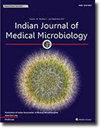Seroprevalence of spotted fever group rickettsiosis in Kashmir: A community-based study using indirect immunofluorescence assay
IF 1.4
4区 医学
Q4 IMMUNOLOGY
引用次数: 0
Abstract
Background and objectives
Rickettsial infections, caused by obligate intracellular Gram-negative bacteria, are an emerging public health concern globally, particularly in regions like India, where the epidemiology remains largely underexplored. The study aimed to determine the seroprevalence of spotted fever rickettsiosis (SFR) in the Kashmir Valley, using the indirect immunofluorescence assay (IFA), the gold standard for rickettsial diagnosis.
Materials and methods
This prospective, population-based study was conducted over three years at the Sher-i-Kashmir Institute of Medical Sciences, Srinagar. A multistage random sampling technique was used and a total of 571 individuals across 10 districts were included in the study. Blood samples were analysed for SFR IgG antibodies using IFA. Data was collected through a house-to-house survey, including demographic and environmental risk factors. Statistical analysis was performed using SPSS version 23, with significance set at P < 0.05.
Results
Of the 571 participants, 143 (25 %) tested positive by IgG immunofluorescence assay for SFR. The majority of seropositive cases were males, 52.4 % (n = 75). Seropositivity was highest in the >50 year age group and among participants having risk factors like contact with uncut vegetations, collection of Firewood And living near Forests. The seroprevalence varied significantly across districts, with the highest prevalence observed in Pulwama. Risk factors associated with higher seropositivity included contact with shrubs, milking and animal slaughtering. No significant associations were found between gender, urban/rural residence, or age group and seropositivity.
Conclusion
This study highlights a high seroprevalence of spotted fever in the Kashmir Valley, emphasizing the significant public health burden in the region. Early detection and targeted prevention strategies, particularly in high-risk areas, are crucial for effective control and management of spotted fever in this region.
克什米尔斑疹热组立克次体病的血清患病率:一项使用间接免疫荧光法的社区研究
背景和目的由专性细胞内革兰氏阴性菌引起的立克次体感染是全球新兴的公共卫生问题,特别是在印度等流行病学尚未充分研究的地区。该研究旨在利用间接免疫荧光法(IFA)确定克什米尔山谷斑点热立克次体病(SFR)的血清患病率,这是立克次体诊断的金标准。材料和方法这项前瞻性的、以人群为基础的研究是在斯利那加的Sher-i-Kashmir医学科学研究所进行的。采用多阶段随机抽样方法,共对10个地区的571名个体进行了调查。用IFA分析血样中SFR IgG抗体。数据是通过挨家挨户的调查收集的,包括人口和环境风险因素。采用SPSS version 23进行统计学分析,显著性设置为P <;0.05.结果571例参与者中,143例(25%)SFR IgG免疫荧光检测阳性。血清阳性病例以男性为主,占52.4% (n = 75)。血清阳性反应在50岁年龄组和有接触未砍伐植被、收集柴火和居住在森林附近等危险因素的参与者中最高。不同地区的血清患病率差异很大,普尔瓦马的患病率最高。与较高血清阳性相关的危险因素包括与灌木接触、挤奶和动物屠宰。性别、城市/农村居住地或年龄组与血清阳性之间未发现显著关联。结论本研究强调了克什米尔谷地斑点热的高血清流行率,强调了该地区重大的公共卫生负担。早期发现和有针对性的预防战略,特别是在高风险地区,对于有效控制和管理本地区的斑点热至关重要。
本文章由计算机程序翻译,如有差异,请以英文原文为准。
求助全文
约1分钟内获得全文
求助全文
来源期刊

Indian Journal of Medical Microbiology
IMMUNOLOGY-
CiteScore
2.20
自引率
0.00%
发文量
154
审稿时长
73 days
期刊介绍:
Manuscripts of high standard in the form of original research, multicentric studies, meta analysis, are accepted. Current reports can be submitted as brief communications. Case reports must include review of current literature, clinical details, outcome and follow up. Letters to the editor must be a comment on or pertain to a manuscript already published in the IJMM or in relation to preliminary communication of a larger study.
Review articles, Special Articles or Guest Editorials are accepted on invitation.
 求助内容:
求助内容: 应助结果提醒方式:
应助结果提醒方式:


